The Art and Science of Package Testing: A Comprehensive Guide
In the world of product marketing, the package isn't just a container—it's a powerful communication tool. A well-designed package can attract customers, communicate your brand's values, and ultimately drive sales. But how can you ensure your package design will resonate with your target audience? The answer lies in package testing, a process that uses a questionnaire to gather consumer feedback on different package designs. In this post, we'll guide you through the process of creating an effective package test questionnaire.
STEP 1: DEFINE YOUR OBJECTIVES
The first step in any research process is to define your objectives. What do you want to learn from your package test? Are you trying to decide between several designs, or are you testing the effectiveness of a single design? Your objectives will guide the rest of your questionnaire development process.
STEP 2: KNOW YOUR AUDIENCE
Understanding your target audience is crucial in package testing. Your package design should appeal to their tastes, preferences, and buying behaviors. When crafting your questionnaire, consider demographic factors (like age, gender, and income) and psychographic factors (like lifestyle and values) to ensure your questions are relevant and engaging.
STEP 3: DEVELOP YOUR QUESTIONS
Now it's time to develop your questions. Remember, your goal is to gather actionable insights about your package design. Ask questions about the package's visual appeal, its ability to stand out on a shelf, and its ability to communicate the product's benefits. Use a mix of question types—multiple choice, rating scales, and open-ended questions—to gather a wide range of data.
STEP 4: USE VISUALS
In package testing, visuals are key. Include images of your package design(s) in your questionnaire. This allows respondents to see exactly what you're asking about and provides you with more accurate feedback.
STEP 5: PILOT YOUR QUESTIONNAIRE
Before you send your questionnaire to your full sample, conduct a pilot test with a smaller group. This allows you to identify any confusing questions or technical issues. Use the feedback from your pilot test to refine your questionnaire before the full launch.
STEP 6: COLLECT AND ANALYZE YOUR DATA
Once your questionnaire is live, it's time to collect and analyze your data. Look for trends and patterns in the responses. Do certain designs consistently rate higher than others? Are there any surprising insights? Use this data to inform your package design process.
STEP 7: APPLY YOUR INSIGHTS
The final step in the process is to apply the insights from your package test to your package design. Use the feedback from your target audience to refine and optimize your design. Remember, the goal of package testing is not just to choose a package design, but to choose a design that will resonate with your target audience and drive product sales.
Package testing is a powerful tool in the product marketer's toolkit. By using a well-crafted questionnaire, you can gather valuable consumer insights and create a package design that truly stands out on the shelf.
Remember, your package isn't just a container—it's a communication tool.
Make sure it's saying the right things.
